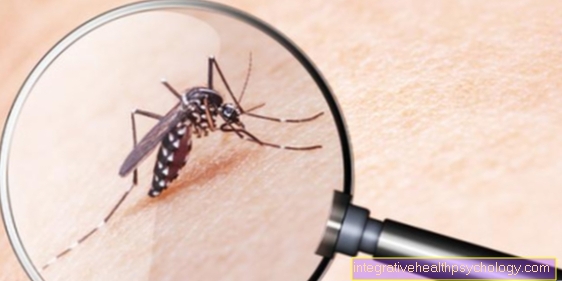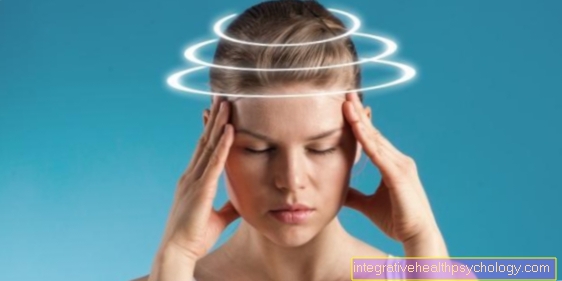Albinism
definition
The term albinism is derived from the Latin word for white, "albus“, From. It is a collective term for a large number of congenital genetic defects, all of which result in those affected suffering from a pigment deficiency, which is particularly noticeable in light skin and hair color.
Albinism does not only exist in humans, but also in the animal world, where those affected are more often referred to as albinos.

The emergence of albinism
Nowadays, 5 genes are known whose mutation causes albinism, although it cannot be ruled out that there are other genes that could be responsible for this.
A distinction is made between oculocutaneous albinism (OCA) type 1, type 2, type 3, type 4 and ocular albinism (OA).
In Europe, types 1 and 2 are mainly found. Most of these genetic defects are inherited as an autosomal recessive trait, which means that both copies that a person has of the gene (both that of the father and that of the mother) must be defective for the disease to ultimately manifest itself.
As a result, two outwardly healthy parents can give birth to a sick child.
In humans, albinism occurs at a frequency of about 1: 20,000, although in certain areas (for example in Africa) there is an accumulation in which the risk of the disease can increase to 1: 10,000 or even higher.
Causes of Albinism
The pigment deficiency can either be due to the fact that the synthesis of the pigment melanin is disturbed or that there is a structural defect in the melanosomes.
The pigment melanin is produced in the melanocytes, specialized cells that are located in the skin. They contain small vesicles, the melanosomes, which contain enzymes that are necessary for melanin synthesis. The most common cause of albinism is a defect in the enzyme tyrosinase (Oculocutaneous albinism type 1). This enables the first step in melanin production, in which the amino acid tyrosine is hydroxylated.
However, albinism does not always appear as an independent disease. Often it is also linked to other symptoms of the disease as part of a syndrome.
Syndromes that are often associated with albinism are the Angelmann and Prader-Willi syndromes, and more rarely Hermansky-Pudlak or Griscelli syndromes.
Symptoms of albinism

The Symptoms albinism vary greatly from individual to individual, since the severity of the disease depends on which component of the synthesis is defective and how great the residual activity of the affected component is, which is almost always present.
This is very classic for albinism light, matt white skin. As a result, these patients are at an increased risk of sunburn and Skin cancer. The structure of the skin is not changed, however.
Besides, the body hair usually very light or really completely white.
Even the rainbow skins of the eyes are lighter than usual due to the lack of melanin. Although they can actually be light blue, light green, or light brown, they often appear reddish because the decreased pigment means that the blood vessels can be seen from inside the eye.
In addition to these physical complaints, many people with albinism suffer from them illness, because it often leads to discrimination or exclusion due to its strikingly different appearance. This phenomenon is usually less pronounced among fair-skinned people, as people with albinism are less noticeable, and incomplete forms can even remain undiagnosed.
Albinism is particularly stigmatizing among dark-skinned peoples, however, and in some peoples there is even a general superstition that people with albinism bring bad luck.
Albinism and eyes
The most common forms of albinism in Europe affect not only the skin but also the skin eyes. The degree of pronounced symptoms varies greatly, however, depending on which genetic defect and which form of albinism is present.
In principle, the pigment deficiency, which can be more or less pronounced in albinism, leads to a Lightening of the eye color. Usually the eyes then appear light blue. The shimmering through of small blood vessels can cause the eyes to appear slightly pink or light red if they are very bright. However, the iris is not directly red in color.
In many cases, however, the pigment deficiency is not so pronounced, so that not everyone with albinism has a reddish-looking iris.
Furthermore, many people with albinism have great eyes photosensitive (Photophobia). Also disturbances of the spatial vision and visual acuity are possible in people with albinism.
The rare one ocular shape Albinism only affects the eyes, while the skin remains normally dark. Because of the poor pigmentation of the iris, patients with albinism usually have a generally increased pigmentation Glare sensitivity.
Other aspects of vision can be impaired as well Melanin is also involved in the development of some components of the visual complex.
For example, a melanin deficiency has a negative effect on the development of the Optic nerves out. This can make it a restricted spatial vision, one Eye tremors (Nystagmus) or a manifest Squint (Strabismus) come.
Also the Visual acuity may be decreased in albinism, since melanin is necessary for the full development of the point of sharpest vision on the Retina (Fovea centralis) is needed. In patients with Albinism is it either only incomplete (Hypoplasia) or even not at all (Aplasia) educated. Often those affected are too short term or farsighted or they can only see contrasts vaguely. The color perception, however, is always unimpaired.
Therapy of albinism
A therapy of the present Genetic defect is still not possible, so one can only treat albinism symptomatically and try to avoid consequential damage from the disease.
Important for people with a Albinism is that she is special UV protection pay attention, as the natural protection due to the lack of pigmentation is missing.
Sufferers should have direct exposure to sunlight so avoid as completely as possible and otherwise always on a very good protection by textiles and Sunscreens respect, think highly of. It is also useful for many patients to use the eyes tinted contact lenses or Glasses to protect and, if necessary, use visual aids. As a result, although the disease cannot be cured, patients can usually lead a largely normal life.
Inheritance
Albinism is a collective term for various genetic defects that lead to one Lack of pigment to lead.
Since there is almost always residual activity in the affected genes, those affected look very different.
Most people with albinism have one thing in common matt white, very light-sensitive skin. Furthermore, the iris of those affected appear red and the scalp hair is very light, almost yellow.
The genetic defects are usually inherited after a autosomal recessive inheritance. That means that affected two defective alleles must have on their chromosomes to develop albinism.
Carrying both defective alleles is known as homozygous. Alleles have to be identified as Forms of expression of a gene imagine.
So if you catch the defective expression of a certain gene twice, you get albinism.
Because the genes on chromosomes are obtained from both the mother and the father, healthy parents can have a child with albinism. If the father and mother each have a defective allele and pass it on to the child, which means that the child receives two defective alleles, it develops albinism.
It's with humans more than five genes knownwhose alteration can lead to albinism.
Further topics from this area

Pigment disorders
Under the term Pigment disorder Many diseases are grouped together, caused by the disturbed formation of the color pigments skin lead to a changed complexion.
Here you get to the topic: Pigment disorder

Skin pigmentation disorder
The pigment melanin is responsible for the coloring of the skin. A disruption in melanin production can lead to increased or decreased pigmentation of the skin. Here you get to the topic: Skin pigmentation disorder

Pigment disorder therapy
Pigment disorders often depend on impaired melanin production. The pigment discoloration can be counteracted with various treatment options.
Here you get to the topic: Pigment disorder therapy






.jpg)






















